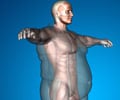Educators and health officials have stepped up their fight against obesity in US schools by trying to replace greasy fast food with healthy meals, and are seeing small but encouraging results.
Educators and health officials have stepped up their fight against obesity in US schools by trying to replace greasy fast food with healthy meals, and are seeing small but encouraging results.
Nearly 13 million children and adolescents in the United States are overweight, a particularly worrying segment of an overall epidemic in a country where 200 million people, or two-thirds of the population, are overweight or obese.Fast food, television, soft drinks and a sedentary lifestyle are seen as the main culprits of childhood obesity, and schools -- in the absence of action on the part of families -- are beginning to take a stand.
"I like to believe we are in the early stages of a social movement and there have been exceptional changes in what schools are doing in nutrition," said William Dietz from the Centers for Disease Control and Prevention.
About 1,800 researchers and general practitioners are taking part in a conference on obesity here, exchanging views on how better to combat obesity at the local or state levels.
A recent CDC study shows that the share of school cafeterias offering their students French fries as the only vegetable item on their menus has dropped from 40 percent in 2000 to 18.8 percent in 2006.
The CDC finances anti-obesity school programs in 23 states, and has seen some positive signs begin to emerge.
Advertisement
The combined bans on junk food in cafeterias and soda drinks in vending machines, as well as a greater emphasis on sports, have paid a dividend: obesity among students in Arkansas has stabilized and even went down slightly -- from 20.9 percent in 2004 to 20.6 percent in 2007.
Advertisement
Despite resistance on the part of some parents who think that schools should not get involved in determining their children's menus, Doctor Allen Queen has developed an intervention model for the schools: an hour of sports every day, plus nutritional education and a better cafeteria.
After two years, attendance increased 11 percent among students and 20 percent among teachers.
But schools cannot offer all the solutions because American children spend only 19.5 percent of their time at school, if vacations and weekends are factored in.
Some experts say that local initiatives will not be enough to win the war against obesity.
"None of this is coordinated. The federal government has to be involved in a systematic way," said John Morton, associate professor at Stanford School of Medicine.
"We won the war on hunger in 1964, we need to win the war on obesity."
Karen Young, medical director for the Pediatric Fitness Clinic at Arkansas Children's Hospital believes the government should forbid advertising of junk food for children.
"I take care of the worst of the worse, those 400, 500-pound (180, 225 kilogram) children who can barely breathe," she said.
Source-AFP
LIN/V









